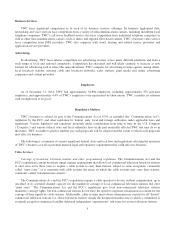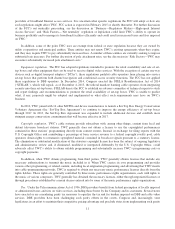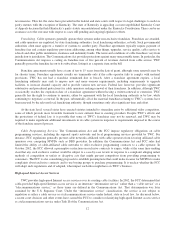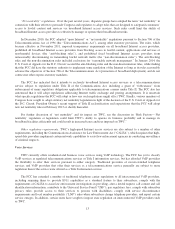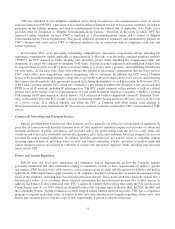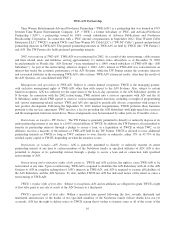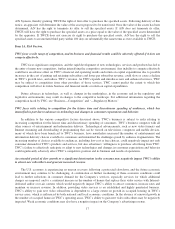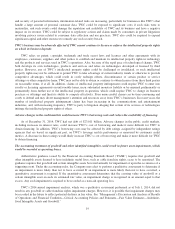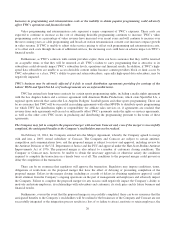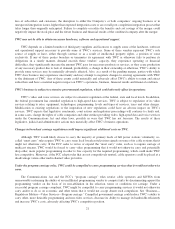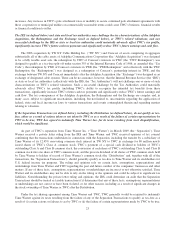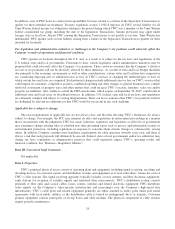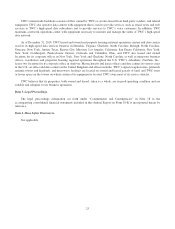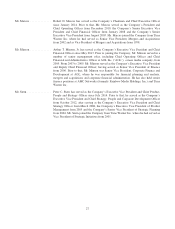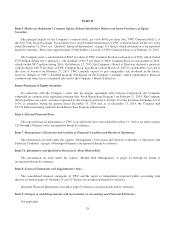Time Warner Cable 2014 Annual Report Download - page 27
Download and view the complete annual report
Please find page 27 of the 2014 Time Warner Cable annual report below. You can navigate through the pages in the report by either clicking on the pages listed below, or by using the keyword search tool below to find specific information within the annual report.and security of personal information, information-related risks are increasing, particularly for businesses like TWC’s that
handle a large amount of personal customer data. TWC could be exposed to significant costs if such risks were to
materialize, and such events could damage the reputation and credibility of TWC and its business and have a negative
impact on its revenue. TWC could be subject to regulatory actions and claims made by consumers in private litigations
involving privacy issues related to consumer data collection and use practices. TWC also could be required to expend
significant capital and other resources to remedy any such security breach.
TWC’s business may be adversely affected if TWC cannot continue to license or enforce the intellectual property rights
on which its business depends.
TWC relies on patent, copyright, trademark and trade secret laws and licenses and other agreements with its
employees, customers, suppliers and other parties to establish and maintain its intellectual property rights in technology
and the products and services used in TWC’s operations. Also, because of the rapid pace of technological change, TWC
both develops its own technologies, products and services and relies on technologies developed or licensed by third
parties. However, any of TWC’s intellectual property rights could be challenged or invalidated, or such intellectual
property rights may not be sufficient to permit TWC to take advantage of current industry trends or otherwise to provide
competitive advantages, which could result in costly redesign efforts, discontinuance of certain product or service
offerings or other competitive harm. TWC may not be able to obtain or continue to obtain licenses from these third parties
on reasonable terms, if at all. In addition, claims of intellectual property infringement could require TWC to enter into
royalty or licensing agreements on unfavorable terms, incur substantial monetary liability or be enjoined preliminarily or
permanently from further use of the intellectual property in question, which could require TWC to change its business
practices or offerings and limit its ability to compete effectively. Even unsuccessful claims can be time-consuming and
costly to defend and may divert management’s attention and resources away from TWC’s businesses. In recent years, the
number of intellectual property infringement claims has been increasing in the communications and entertainment
industries, and, with increasing frequency, TWC is party to litigation alleging that certain of its services or technologies
infringe the intellectual property rights of others.
Adverse changes in the credit markets could increase TWC’s borrowing costs and reduce the availability of financing.
As of December 31, 2014, TWC had net debt of $23.011 billion. Adverse changes in the public credit markets,
including increases in interest rates, could increase TWC’s cost of borrowing and make it more difficult for TWC to
obtain financing. In addition, TWC’s borrowing costs may be affected by debt ratings assigned by independent ratings
agencies that are based, in significant part, on TWC’s leverage and its performance as measured by customary credit
metrics. A decrease in these ratings would likely increase TWC’s cost of borrowing and make it more difficult for TWC
to obtain financing.
The accounting treatment of goodwill and other identified intangibles could result in future asset impairments, which
would be recorded as operating losses.
Authoritative guidance issued by the Financial Accounting Standards Board (“FASB”) requires that goodwill and
other intangible assets deemed to have indefinite useful lives, such as cable franchise rights, cease to be amortized. The
guidance requires that goodwill and certain intangible assets be tested annually for impairment or upon the occurrence of a
triggering event. Under the accounting rules, the Company may elect to perform a qualitative assessment to determine if
an impairment is more likely than not to have occurred. If an impairment is more likely than not to have occurred, a
quantitative assessment is required. If the quantitative assessment determines that the carrying value of goodwill or a
certain intangible asset exceeds its estimated fair value, an impairment charge is recognized in an amount equal to that
excess. Any such impairment is required to be recorded as a noncash operating loss.
TWC’s 2014 annual impairment analysis, which was a qualitative assessment performed as of July 1, 2014, did not
result in any goodwill or cable franchise rights impairment charges. However, it is possible that impairment charges may
be recorded in the future to reflect potential declines in fair value. See “Management’s Discussion and Analysis of Results
of Operations and Financial Condition—Critical Accounting Policies and Estimates—Fair Value Estimates—Indefinite-
lived Intangible Assets and Goodwill.”
19


